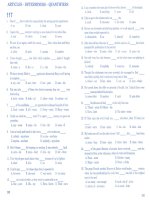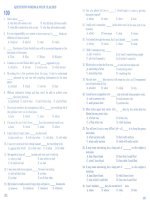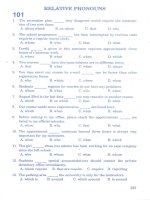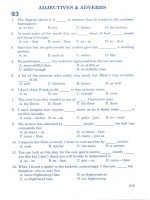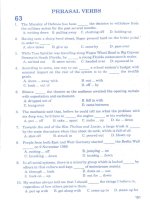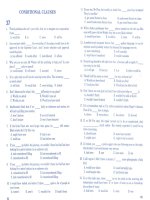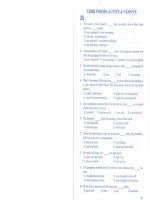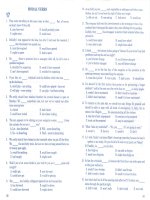Chuyên sâu ngữ pháp tiếng anh 7 sách thí điểmdocx
Bạn đang xem bản rút gọn của tài liệu. Xem và tải ngay bản đầy đủ của tài liệu tại đây (1.36 MB, 183 trang )
1
UNIT 1: MY HOBBIES
A. GRAMMAR - NGỮ PHÁP
I. THE PRESENT SIMPLE - Thì hiện tại đơn
1. Cấu trúc thì hiện tại đơn với động từ "To be"
1.1 Câu khẳng định
S + is/ am/ are + ...
- Trong đó: S (subject) = Chủ ngữ
CHÚ Ý:
- Khi S = I + am
- Khi S = He/ She/ It + is
- Khi S = We/ You/ They + are
Ví dụ:
➢I am a student. (Tôi là sinh viên.)
Ta thấy với chủ ngữ khác nhau động từ "to be" chia khác nhau.
1.2 Câu phủ định
S + is/ am/ are + not + ...
CHÚ Ý:
- am not: khơng có dạng viết tắt
- is not = isn't
- are not = aren't
Ví dụ:
➢He isn’t my little brother. (Cậu ấy không phải là em trai của tôi.)
1.3 Câu nghi vấn
Am/ Is/ Are + S+ ...?
Trả lời: Yes, I + am. - Yes, he/ she/ it + is. - Yes, we/ you/ they + are.
No, I + am not. - No, he/ she/ it + isn't - No, we/ you/ they + aren't.
Ví dụ:
➢Are you Jananese? (Bạn là người Nhật đúng không vậy?)
- No, I am not. I'm Vietnamese. (Khơng. Tơi là người Việt Nam.)
2. Cấu trúc thì hiện tại đơn với động từ thường
2.1 Câu khẳng định
S + V(s/es)
Trong đó: - S (subject) = Chủ ngữ
Bài tập Tiếng Anh 7 | 1
2
- V (verb) = Động từ
CHÚ Ý:
- S = I, We, You, They, danh từ số nhiều thì động từ ở dạng nguyên thể
- S = He, She, It, danh từ số ít thì động từ thêm "S" hoặc ES"
Ví dụ:
➢We go to school by bus everyday. (Chúng tơi đến trường bằng xe buýt hàng
ngày.)
Trong câu này, chủ ngữ là "She" nên động từ chính "go" phải thêm "es".
2.2 Câu phủ định
S + don't/ doesn't + V (nguyên thể)
Lưu ý:
• don't - do not
• doesn't - does not
CHÚ Ý:
S = I, We, You, They, danh từ số nhiều - Ta mượn trợ động
từ "do" + not
S = He, She, It, danh từ số ít - Ta mượn trợ động từ "does"
+ not
- Động từ (V) theo sau ở dạng NGUN THỂ khơng
chia.
Ví dụ:
➢ I don't usually go swimming. (Tơi không thường xuyên đi bơi.)
➢ She doesn't like football. (Cô ấy khơng thích bóng đá.)
2.3 Câu nghi vấn
Do/ Does + S + V(nguyên thể)?
Trả lời: Yes, I/we/you/they + do./ Yes, he/she/it + does.
No, I/we/you/they + don't/ No, he/she/it + doesn't. CHÚ Ý:
S = I, We, You, They, danh từ số nhiều - Ta mượn trợ động từ
"Do" đứng trước chủ ngữ
S = He, She, It, danh từ số ít - Ta mượn trợ động từ "Does" đứng
trước chủ ngữ
- Động từ chính trong câu ở dạng NGUYÊN THỂ.
Ví dụ:
➢ Do you stay with your family? (Bạn có ở cùng với gia đình khơng?)
➢ Yes, I do./ No, I don't. (Có, tớ ở cùng với gia đình./ Khơng, tớ khơng ở cùng.)
Bài tập Tiếng Anh 7 | 2
3
Trong câu này, chủ ngữ là "you" nên ta mượn trợ động từ "Do" đứng trước
chủ ngữ, động từ chính "stay" ở dạng nguyên thể.
➢ Does your mother like cooking? (Mẹ của bạn có thích nấu ăn khơng?)
➢ Yes, she does./ No, she doesn't. (Có, bà ấy thích nấu ăn./ Khơng, bà ấy khơng
thích.) Trong câu này, chủ ngữ là "your mother" (tương ứng với ngôi "she")
nên ta mượn trợ động từ "Does" đứng trước chủ ngữ, động từ chính "like" ở
dạng nguyên thể.
3. Cách sử dụng thì hiện tại đơn
Diễn tả một hành động, sự việc diễn ra thường xun, lặp đi lặp lại hay một
thói quen.
Ví dụ:
➢ They drive to the office every day. (Hàng ngày họ lái xe đi làm.)
➢ She doesn’t come here very often. (Cô ấy không đến đây thường xuyên.)
Diễn tể một sự thật hiển nhiên, một chân lý
Ví dụ:
➢ The sun rises in the East and sets in the West. (Mặt trời mọc ở đằng Đông, và
lặn ở đằng Tây.)
Đây là một sự thật hiển nhiên nên ta sử dụng thì hiện tại đơn để diễn tả. Chủ ngữ là
"the sun" (số ít, tương ứng với "ít") nên động từ "rise" và "set" ta phải thêm "s".
Diễn tả sự việc sẽ xảy xa theo lịch trình, thời gian biểu rõ ràng như giờ tàu,
máy bay chạy...
Ví dụ:
➢ Christmas Day falls on a Monday this year. (Năm nay Giáng sinh rơi vào
ngày thứ Hai.)
➢ The flight starts at 7 am tomorrow. (Chuyến bay sẽ bắt đầu vào lúc 7h sáng
ngày mai.)
Diễn tả suy nghĩ, cảm xúc, cảm giác.
Ví dụ:
➢ I think he is a good boy. (Tôi nghĩ cậu ấy là một chàng trai tốt.)
➢ She feels very tired now. (Bây giờ cô ấy cảm thấy rất mệt.)
4. Dấu hiệu nhận biết thì hiện tại đơn
Trong câu có các trạng từ chỉ tần suất:
- always:
luôn luôn
Bài tập Tiếng Anh 7 | 3
4
- usually:
- normally:
thường thường
thường thường
- often:
- frequently:
thường xuyên
thường xuyên
- sometimes:
thỉnh thoảng
- rarely:
hiếm khi
- seldom:
hiếm khi
- every day/ week/ month/ year: hàng ngày, hàng tuần, hàng tháng,
hàng năm
- once:
một lần (once a month: một tháng 1 lần)
- twice:
hai lần (twice a week: hai lần 1 tuần)
- three times:
- never:
- first..., then...:
ba lần (three times a day: 3 lần 1
ngày) không bao giờ
trước tiên ..., sau đó ... (khi u cầu mơ phỏng,
đưa ra chỉ dẫn cụ thể để thực hiện một việc
nào đó
Chú ý: từ “ba lần” trở lên sử dụng: số đếm + times
Ví dụ:
➢ She sees grandparents four times a month. (Cô ấy đến thăm ông bà 1 tháng 4
lần.)Vị trí của trạng từ chỉ tuần suất trong câu:
- Các trạng từ: always, usually, often, sometimes, rarely, seldom...- đứng trước
động từ thường, đứng sau động từ "to be" và trợ động từ.
Ví dụ:
➢ He is usually at home in the evening. (Anh ấy thường ở nhà vào buổi tối.)
➢ I don't often go out with my friends. (Tôi không thường xuyên ra ngoài với
bạn bè.)
5. Quy tắc thêm "s" hoặc "es" sau động từ
−Thông thường ta thêm "s" vào sau các động từ.
Ví dụ:
work - works
read - reads
like - likes
dance - dances
−Những động từ tận cùng bằng: -s; -sh; -ch; -z; -x; -o ta thêm "es".
Bài tập Tiếng Anh 7 | 4
5
Ví dụ:
miss - misses
wash - washes
watch - watches
buzz - buzzes
−Những động từ tận cùng là "y":
+ Nếu trước "y" là một nguyên âm (a, e, i, o, u) - ta giữ nguyên "y" + "s"
Ví dụ: play - plays; buy - buys; pay - pays
+ Nếu trước "y" là một phụ âm - ta đổi "y" thành "i" + "es"
Ví dụ: fly - flies; cry - cries; fry - fries
−Trường hợp đặc biệt:
Ta có: have - has
Động từ "have" khi đi với chủ ngữ là ngơi thứ 3 số ít sẽ khơng thêm "s" mà biến đổi
thành "has".
Ví dụ:
➢She has three cats. (Cơ ấy có 3 con mèo.)
BỘ ĐỀ ĐÁP ÁN HSG MÔN ANH CẤP HUYỆN, TỈNH FILE WORD Zalo
0946095198
150 ĐỀ ĐÁP ÁN HSG ANH 6=80k;
235 ĐỀ ĐÁP ÁN HSG ANH 7=100k
200 ĐỀ ĐÁP ÁN HSG ANH 8=100k;
240 ĐỀ ĐÁP ÁN HSG ANH 9=100k
II. THE FUTURE SIMPLE TENSE (THI TƯƠNG LAI ĐƠN)
1. Cấu trúc 1.1 Câu khẳng
định S + will + V (nguyên thể)
Trong đó:
S (subject):
Chủ ngữ will: trợ động từ
V (nguyên thể):
động từ ở dạng nguyên thể
CHÚ Ý
I will = I'll; They
will = They'll; It will = It'll
He will = He'll;
We will = We'll She will = She'll;
You will =You'll
Ví dụ:
➢ My mother will help me care for my babies tomorrow. (Ngày mai mẹ tơi sẽ
chăm sóc bọn trẻ giúp tôi.)
➢ She will bring you a cup of tea soon. (Cô ấy sẽ mang cho bạn một tách trà
sớm thôi.)
Bài tập Tiếng Anh 7 | 5
6
1.2 Câu phủ định
S + will not + V(nguyên thể)
Câu phủ định trong thì tương lai đơn ta chỉ cần thêm "not" vào ngay sau "will".
CHÚ Ý:
will not = won't Ví dụ:
➢ I won't tell him the truth. (Tơi sẽ khơng nói với anh ấy sự thật.)
➢ We won't finish our report in 2 days. (Chúng tôi sẽ không thể hồn thành bài
báo cáo trong vịng 2 ngày.)
1.3 Câu nghi vấn
Will + S + V(nguyên thể)?
Trả lời: Yes, S + will./ No, S + won't.
Câu hỏi trong thì tương lai đơn: ta chỉ cần đảo "will" lên trước chủ ngữ.
Ví dụ:
➢ Will they come here tomorrow? (Họ sẽ đến đây vào ngày mai chứ?)
Yes, they will./ No, they won't. (Đúng, họ sẽ đến. / Không, họ không đến.)
➢ Will you take me to the zoo this weekend? (Mẹ sẽ cho con đến vườn bách thú
chơi vào cuối tuần này chứ mẹ?)
Yes, I will./ No, I won't. (Ừ, được./ Không được.)
2. Cách sử dụng của thì tương lai đơn
Nói về một hành động hay một sự việc sẽ xảy ra trong tương lai.
Ví dụ:
➢She'll be twenty on Sunday. (Cơ ấy sẽ tròn 20 tuổi vào Chủ Nhật tới.)
Diễn tả một quyết định, một ý định nhất thời xảy ra ngay tại thời điểm
nói.
Ví dụ:
➢What would you like to drink? I'll have a mineral water. (Anh muốn uống gì?
Tơi sẽ uống nước suối.)
Diễn tả một dự đốn khơng có căn cứ.
Ví dụ:
➢She supposes that she will get a better job. (Cô ấy tin rằng cô ấy sẽ kiếm được
một công việc tốt.)
Diễn tả một lời hứa hay lời yêu cầu, đề nghị.
Bài tập Tiếng Anh 7 | 6
7
Ví dụ:
➢I promise I will return school on time. (Tơi hứa tôi sẽ trở về trường đúng
giờ.)➢Will you please bring me a cup of coffee? (Bạn làm ơn mang cho tôi một
tách cà phê được không?)
Sử dụng trong điều kiện loại một, diễn tả một giả định có thể xảy ra ở
hiện tại và tương lai.
Ví dụ:
➢If it stops raining soon, we will go to the cinema. (Nếu trời tạnh mưa sớm thì
chúng tơi sẽ đi tới rạp chiếu phim.)
3. Dấu hiệu nhận biết thì tương lai đơn
Trong câu có các trạng từ chỉ thời gian trong tương lai như:
▪In + thời gian: trong... nữa (in 2 minutes: trong 2 phút nữa)
▪ Tomorrow: ngày mai
▪ Next day: ngày hôm tới
▪ Next week/ next month/ next year: tuần tới/ tháng tới/ năm tới
▪ The day after tomorrow: ngày kia
▪ Soon: chẳng bao lâu nữa
▪ Someday: một ngày nào đó
Trong câu có những động từ chỉ quan điểm như:
▪ think/ believe/ suppose/...: nghĩ/ tin/ cho là
▪ perhaps: có lẽ
▪ probably: có lẽ
III. VERB FOLLOWED BY GERUND (ĐỘNG TỪ THEO SAU BỞI V-ING)
Cấu trúc:S + like/ love/ enjoy/ hate +V-ing Ví
dụ:
➢ I like swimming. (Tơi thích bơi lội.)
➢ She hates washing clothes. (Cô ấy ghét giặt quần áo.)
➢ My father doesn't like mountain - climbing. (Bố tơi khơng thích leo núi.)
Ngồi ra, sau những động từ chỉ sở thích này chúng ta cũng có thể dùng to infinitivemà nghĩa của câu khơng hề thay đổi.
Ví dụ:
➢ My sister loves to make model. (Chị gái tơi thích cơng việc làm người mẫu.)
Bài tập Tiếng Anh 7 | 7
8
B. VOCABULARY - TỪ VỰNG
Từ mới
gymnastics
gardening
camping
take photos
basketball
cycle
skating
table tennis
bird - watching
aerobics
chess
swimming
walk
talk
go
paint
collect
dance
ride
watch
listen
play
eat
to hang out with
friends
to chat with friends
to do sports
to play computer
games
to walk the dog
to play the guitar
Phiên âm
/dʒɪmˈnæstɪks/
/ˈɡɑːdnɪŋ/
/ˈkæmpɪŋ/
/teɪk ˈfoʊtoʊ/
/ˈbæskɪtbɔːl/
/ˈsaɪkl/
/ˈskeɪtɪŋ/
/ˈteɪbl ˈtenɪs/
/ˈbɜːrdwɑːtʃɪŋ/
/eˈroʊbɪks/
/tʃes/
/ˈswɪmɪŋ/
/wɔːk/
/tɔːk/
/ɡoʊ/
/peɪnt/
/kəˈlekt/
/dæns/
/raɪd/
/wɑːtʃ/
/ˈlɪsn/
/pleɪ/
/iːt/
/hæŋ aʊt wɪð frendz/
Nghĩa
thể dục
làm vườn
cắm trại
chụp ảnh
bóng rổ
đạp xe
trượt băng
bóng bàn
ngắm chim
thể dục nhịp điệu
cờ vua
bơi
đi bộ
nói chuyện
đi
vẽ
sưu tập
nhảy, múa
đạp xe
xem
nghe
chơi
ăn
ra ngồi với bạn
/tʃỉt wɪð frendz/
/də spɔːt /
/pleɪ kəmˈpjuːtər
ɡeɪmz/
/wɔːk ðə dɒɡ/
/pleɪ ðə ɡɪˈtɑː(r)/
nói chuyện với bạn
chơi thể thao
chơi game
dắt chó đi dạo
chơi ghi-ta
C. EXERCISES - BÀI TẬP THỰC HÀNH
Bài tập Tiếng Anh 7 | 8
9
PART 1. PHONETICS
1. Put the words with the underlined part in the box into two groups.
again
first
family
bird
her
learn
American
world
student
never
assistant
birthday
teacher
heard
camera
dependent
after
girl
neighbour
person
/ə/
/ɜː/
2. Find the word which has a different sound in the part underlined.
1. A. future B. return C. picture D. culture
2. A. hobby B. collect C. doll
D. over
3. A. collect B. concern C. combine
D. convey
4. A. piano B. fish
C. like
D. badminton
5. A. arrange B. game C. make D. skate
PART 2: VOCABULARY & GRAMMAR
1. Match the nouns from the box with the correct verb.
stamps
coins
camping
board games
research
chess
cartoons
jogging
violent
boating
gymnastics
football
shopping
judo
flute
buttons
dolls
Aerobics
bowling
fishing
1. Go:..................................................................................................................
.................... 2.
Do:..................................................................................................................
.................... 3.
Collect: ..........................................................................................................
..................... 4.
Play: ...............................................................................................................
....................
Bài tập Tiếng Anh 7 | 9
10
2. Circle A, B, C or D for each picture.
1.
4.
A.mountain- climbing
B.skating
C.horse- riding
D.dancing
2.
A.walking
B.swimming
C.taking photos
D.bowling
5.
A.gardening
B.singing
C.arranging flowers
D.bird-watching
3.
A.playing the guitar
B.making models
C.collecting coins
D.cycling
6.
A.talking
A.carving wood
B.painting
B.doing experiment
C.eating
C.listening to the radio
D.taking
D.watching a movie
3. Find one odd word A, B, C or D.
1. A. watching TV
B. playing games C. collecting
D. cartoon
2. A. paint B. listen C. take
D. flower
3. A. cycling
B. music C. skating D. climbing
4. A. pottery
B. photo C. love
D. wood
5. A. gymnastics B. camping C. fishing D. horse-riding
4. Puts the verbs in brackets in the correct verb form.
1. I (think)
that mountain-climbing is very dangerous.
Bài tập Tiếng Anh 7 | 10
11
2. My father (like)
collecting stamps so much.
3. She (take)
a lot of photos when she (go)
on holidays.
4. I like drawing very much. My hobby is (paint)
.
5. My mother says when she (retire)
, she (go)
back to her village to do the gardening.
6.
your sister (like) (make)
model in her free time?
7. My brother (promise) that he (give)
me a nice doll
on my birthday.
8. Duong says he loves horse-riding but he (not/ continue) this hobby from
next year.
9. My aunt (play)
the guitar once a week.
10. Don't worry. I (dance)
with you next Sunday.
5. Fill each blank with a word/ phrase in the box.
go
chess
gymnastics books
camping
dolls
cooking
bottles
music
fishing
1. I like
. I usually play against my brother. I also
play against other
people on the Internet
2. My younger sister likes collecting
. Now she has more than 50.
3. I'm interested in
. My idol is My Tam.
4. My girl friend likes doing
, so she has a nice body.
5. I never
skiing.
6. My father like reading
. His favorite writer is Van Cao.
7. My hobby is
with my friends when I have some
days off.
8. My family usually goes
on weekends.
9. He likes collecting
, especially glasses.
10. My mother likes
. She can cook lots of
delicious dishes. PART 3: READING
1. Fill in the blank with a word/ phrase in the box.
gardening
feel
planting
seeing
blooming
myself
exercise
rejuvenate
healthy
watering
Bài tập Tiếng Anh 7 | 11
12
My favourite hobby is (1) and I like so much (2)
new plants and (3)
them in daily morning. I enjoy seeing flowers (4) and plants
(5). I really (6) sense of great achievements and realize the fact of life. It helps me
keep (7)
fit, (8), strong and (9)
. Watering plants and
gardening on daily basis is a best (10) for me which positively moulds my mind and
body.
2. Choose the correct answer A, B, C or D to fill each blank in the following
passage.
My favourite hobby is coin (1)
. It is also one of the oldest (2)
of
the world and is also called 'hobby of the Kings', as in the old times, it was only
done by kings and elite class of the society. It started for me some years back when
my father used to come back (3)
his foreign tours and give me coins
of (4)
countries.
I started collecting them in my money box and after that I always used to wait for
my new coins as much I used to wait for my father. Since then, it has become my
favourite hobby. This hobby has given me information about different countries of
the world. I feel extreme pleasure in (5) my collection to (6). It has also taught me
this lesson that A LIFE (7) A HOBBY IS JUST (8)FOOD WITHOUT SALT.
1. A. collecting
B. collection
C. collectedD. collectors
2. A. hobby B. hobbies C. game D. games
3. A. after
B. in C. from
D. of
4. A. other
B. different C. unlike D. diverse
5. A. showing B. show
C. shown D. to show
6. A. other
B. another C. others D. person
7. A. with
B. about C. without D. of
8. A. as B. like
C. if D. likes
3. Read the article and then decide whether the statements are true (T) or (F).
After school Kien usually goes swimming. He goes to the swimming pool five
times a week. His swimming pool is very good. The pool is 25 metres long and has
six lanes. More than a thousand children have swimming lessons there every month.
His swimming instructor is experienced and friendly, but she is also strict. She
Lessons last 45 minutes, but he usually trains for an hour and a half. During the
lesson he swims about two kilometers. His favourite swimming styles are crawl an
backstroke.
Bài tập Tiếng Anh 7 | 12
13
He practices a lot to improve his swimming skills. He wants to achieve good
results. Last month he participated in a swimming competition. Ten swimmers from
three schools took part in the competition. He won first prize.
Swimming is his favourite sport. Swimming is interesting and pleasant, and it helps
him to keep fit.
True or False?
Kien goes to home after school.
He practices swimming five times a month.
His swimming instructor is so hard.
He swims about five kilometers during the lesson.
The best friend won first prize in the swimming competition.
PART 4: WRITING 1.
Make up sentences using the words and phrases given.
1.when/ I/ ten/ begin/ play football.
.......................................................................................................................................
.........
2.in/ future/ my father/ go abroad.
.......................................................................................................................................
.........
3.read/ books/ free time/ is/ favourite/ hobby.
.......................................................................................................................................
.........
4.I/ think/ skate/ more/ interesting/ mountain - climbing.
.......................................................................................................................................
.........
5.I /not/ know/ why/ my mother/ cook.
.......................................................................................................................................
.........
6.He/ collect/ books/ whenever/ have/ money.
.......................................................................................................................................
.........
7.How many/ paintings/ she/ paint?
.......................................................................................................................................
.........
8.I/ love/ flowers/ so/ I/ plant/ around/ house.
Bài tập Tiếng Anh 7 | 13
14
.......................................................................................................................................
.........
UNIT 2: HEALTH
A. GRAMMAR - NGỮ PHÁP
I. IMPERATIVES WITH MORE AND LESS (Câu mệnh lệnh với more và less)
1. Cấu trúc: VERB + MORE/LESS + NOUN
2. Cách sử dụng
Câu mệnh lệnh dùng để hướng dẫn, ra lệnh, yêu cầu hoặc gợi ý.
Ví dụ:
➢ Watch less TV! (Xem ti vi ít thôi)
➢ Do more exercises! (Làm nhiều bài tập hơn nữa)
➢ Spend less time playing computer games. (Chơi trò chơi máy tính ít thơi.)
II. COMPOUND SENTENCE (Câu ghép)
Câu ghép là câu có hai hay nhiều mệnh đề độc lập được nối với nhau bằng liên từ.
Cách thành lập câu ghép:
1. Dấu chấm phẩy (semicolons)
−Dấu chấm phẩy (;) được dùng nối hai mệnh đề độc lập để tạo thành câu ghép
−Nếu không dùng từ nối như cách 1 thì cần dùng dấu "chấm phấy", khơng được
dùng dấu phẩy
Ví dụ:
➢The bus was very crowded; I had to stand all the way.
(Xe buýt đông quá nên tôi phải đứng cả dọc đường.)
2. Từ nối (conjunctions)
−Các mệnh đề độc lập được nối với nhau bằng các từ nối: for, and, nor, but, or,
yet, so để tạo nên câu ghép
−Đặt dấu phẩy trước từ nối
Ví dụ:
➢The bus was very crowded, so I had to stand all the way.
3. Trạng từ nối (conjunctive adverbs)
− Cách thứ 3 để nối hai mệnh đề độc lập tạo thành câu ghép là dùng
trạng từ nối
− Trạng từ nối phải được đứng sau dấu ";"và trước dấu ","
Bài tập Tiếng Anh 7 | 14
15
Ví dụ
➢The bus was very crowded; therefore, I had to stand all the way.
Một số từ nối thông dụng:
; accordingly,
; also,
; as a matter of
fact,
; clearly,
; consequently,
; finally,
; first,
; for instance,
; for example.
; furthermore,
; hence,
; however,
; in addition,
; in fact,
; in general,
; in other
words,
; in short,
; moreover,
; nevertheless,
; obviously,
; of course,
; otherwise,
; similarly,
; still,
; then,
; therefore,
; thus,
;
unfortunately
B. VOCABULARY - TỪ VỰNG
Từ mới
allergy
backache
toothache
headache
earache
bruise
cold
cough
cut
dizziness
fever
temperature
flu (viết tắt của
influenza)
obesity
sore throat
sick/ ill
brush the teeth
regularly
have regular
medical check up
Phiên âm
/ˈælədʒi/
/ˈbækeɪk/
/ˈtuːθeɪk/
/ˈhedeɪk/
/ˈɪreɪk/
/bruːz/
/kəʊld/
/kɒf/
/kʌt/
/ˈdɪzinəs/
/ˈfiːvə(r)/
/ˈtemprətʃər/
Nghĩa
dị ứng
bệnh đau lưng
đau răng
đau đầu
đau tai
vết thâm tím
cảm lạnh
ho
vết đứt
chóng mặt
sốt
sốt
/fluː/
cúm
/əʊˈbiːsəti/
/sɔː(r) θrəʊt /
/sɪk/ /ɪl/
/brʌʃ ðə tiːθ ˈreɡjələli/
bệnh béo phì
đau họng
bệnh
đánh răng thường
xuyên
/həv ˈreɡjələr ˈmedɪk(ə)l
đi khám định kì
tʃek ʌp/
Bài tập Tiếng Anh 7 | 15
16
take some medicine
go to see a doctor
go to see a dentist
do more exercise
/teɪk sʌm ˈmedɪsn/
/ɡəʊ tuː siː ə ˈdɒktə/
/ɡəʊ tuː siː ə ˈdentɪst/
/duː mɔː ˈeksərsaɪz/
sleep more
eat healthy food
/sliːp mɔː/
/iːt ˈhelθi fuːd/
medicine
to bleed
/ˈmedɪsn/
/bliːd/
uống thuốc
gặp bác sỹ
gặp nha sỹ
tập thể dục nhiều
hơn
ngủ nhiều hơn
ăn đồ tốt cho sức
khỏe
thuốc
chảy máu
C. EXERCISES - BÀI TẬP THỰC HÀNH
PART 1. PHONETICS
1. Find the word which has a different sound in the part underlined. Read the
words aloud.
1. A. of B. coffee C. leaf
D. fault
2. A. cough B. laugh C. enough D. through
3. A. knee
B. knife
C. king
D. knitting
4. A. daughter B. weigh C. rough D. thought
5. A. knives B. draught C. flu D. tough
2. Put the words in the box into two groups.
knife
cough
phone
knives
leave
of
laugh
live
life
food
vase
flower
fruit
leaves
very
/v/
/f/
PART 2: VOCABULARY & GRAMMAR
1. Find one odd word A, B, C or D.
1. A. temperatureB. ill C. headache
D. flu
2. A. sick B. ill C. unhealthy
D. backache
Bài tập Tiếng Anh 7 | 16
17
3. A. and B. or C. however D. so
4. A. hurt B. weak
C. sleepy D. tired
5. A. pain B. hurt
C. itchy
D. burn
2. Circle A, B, C or D for each picture.
1.
2.
A.sleepy
B.fat
C.tired
D.weak
A.have a cough
B.have a temperature
C.have earache
D.have sore throat
3.
4.
A.have a headache
B.have a sore throat
C.have an allergy
D.have a stomachache
5.
A.feel sick
B.feel tired
C.feel sleepy
D.fell unhealthy
6.
A. spending less time on
A.seeing the dentist
computer games
B.take medicines
B. doing exercise
C.brushing teeth
C. wearing sun hat
D.washing face
D. watching less TV
3. Fill in the blank with a word in the box.
put on
exercise
spending
sun hat
obesity
rest
tooth decay clean
allergic
bright
Bài tập Tiếng Anh 7 | 17
18
eyes
1. If you brush your teeth regularly you will not have
.
2. You look tired. You should
more.
3. Today the weather is cold, so you should
your
warm
clothes.
4. Some people are
to crab.
5. If you want to be healthy, you should eat less fast food and do more
.
6. Today it is very hot. Please wear a
when you go out.
7. Eating too many sweets and fast foods causes health problems such as
tooth decay,
.
8. Eating carrots regularly will help you have
.
9. You can avoid some diseases by keeping your hands
.
10.
more time on computer games may lead to sore
eyes.
4. Complete the sentences using more or less.
1. You should eat fruits and vegetables because they are good for your
health.
2. She looks very tired after coming back from work. She should rest
.
3. We should spend
time on computer games.
4. Drink
green tea and
coffee.
5. Smoking can lead to lung cancer, so smoke .
6. If you wash your hands
than you will be less chance of having
flu.
7. Eat
high-fat food keep you from getting fat.
8. Which activity burns
calories, walking or riding a bicycle?
5. Put the verbs in brackets in the correct tense form.
1. It is important (eat)
well.
Bài tập Tiếng Anh 7 | 18
19
2. It (be) very cold today. You should wear your warm clothes when you (go)
out to prevent cold.
3. Do morning exercise every day and you’ll (feel)
better.
4. I have a lot of homework to do this evening, so I (not have) ________ time
to watch the football match.
5.
(Eat)
junk food and inactivity (be) the main
causes of obesity.
6.
I (have) a headache and I need to rest more.
7. I (have) a toothache so I (have to/ see)
the dentist.
8. I have to take medicines because I (be)
sick.
9. Japanese (eat)
more fish instead of meat, so they (stay)
more healthy.
10. When you (have)
a
fever,
you
(should/
drink)
more water and rest more.
11. A healthy diet (help)
us feel healthier.
12. Watching TV much (hurt)
your eyes.
PART 3: READING
1. Put a word from the box in each gap to complete the following passage.
diet
contribute
calories
overweight
physical
activity
more
lifestyle
cause
Causes of Childhood Obesity
Family history; psychological factors, and (1) all play a role in childhood obesity.
Children whose parents or other family members are (2) or obese are more likely to
follow suit. But the main (3) of childhood obesity is a combination of eating too
much and exercising too little.
A poor (4)
containing high levels of fat or sugar and few nutrients
can cause kids to gain weight quickly. Fast food, candy, and soft drinks are common
culprits. The U.S. Department of Health & Human Services (HHS) reports that 32
percent of adolescent girls and 52 percent of adolescent boys in the United States
drink 24 ounces of soda - or more - per day. Convenience foods, such as frozen
dinners, salty snacks, and canned pastas, can also (5) to unhealthy weight gain.
Bài tập Tiếng Anh 7 | 19
20
Some children become obese because their parents don't know how to choose or
prepare healthy foods. Other families may not be able to easily afford fresh fruits,
vegetables, and meats.
Not enough (6)
can be another cause of childhood obesity. People of' all
ages tend to gain weight when they're less active. Exercise burns (7)
and helps you maintain a healthy weight. Children who aren't encouraged to be
active may be less likely to burn extra calories through sports, time on the
playground, or other forms of physical activity. Psychological issues may also lead
to obesity in some children. Kids and teens who are bored, stressed, or depressed
may eat (8) to cope with negative emotions.
2. Choose the correct word A, B, or C for each gap to complete the following
passage. What You Can Do To Stay Healthy
Evidence shows that some of the leading causes of death such as heart disease,
cancer, stroke, some lung diseases can be prevented by improving personal health
(1). Eating right, staying physically active, and not smoking are a few examples of
good habits that can help you stay healthy.
Eating Right
Eating the right foods and the right (2) of foods can help you live a longer, healthier
life. Research has proven that many illnesses - such as diabetes, heart disease, and
high blood pressure - can be prevented or controlled by eating right. Getting the (3)
you need, such as calcium and iron, and keeping your weight under control can
help. Try to (4) the calories you get from food with the calories you use through
physical activity. It is never too late to start eating right. Here are some (5)
tips.
Eat a (6)
of foods, especially: Vegetables, Fruits, Dry beans (such as
red beans, navy beans, and soybeans), whole grains, such as wheat, rice, oats, corn,
and barley.
Eat foods low in fat, saturated fat, and cholesterol, especially: Fish, poultry
prepared without skin; lean meat, (7)
dairy products.
Physical Activity
Research shows that physical activity can help prevent at least six diseases: heart
disease, high blood pressure, obesity (excess weight), diabetes, osteoporosis, and
mental disorders, such as depression. Physical activity also will help you feel better
and stay at a healthy weight. Try to do a total of 30 minutes of constant physical
activity, such as fast (8)
most days of the week.
1. A. habits B. routine C. habit
Bài tập Tiếng Anh 7 | 20
21
2.
3.
4.
5.
6.
7.
8.
A. quantity B. amounts C. number
A. nutrients B. foods C. drinks
A. balancing
B. gain
C. balance
A. helpful B. good
C. important
A. variety B. diversified
C. varied
A. high-fat B. low-fat C. no-fat
A. waking B. driving C. eating
PART 4: WRITING
1. Make sentences using the words and phrases given.
1. Eat / healthy / diet / and / do / exercise / regularly / help / you / stay / healthy.
.......................................................................................................................................
.........
2. We / need / calories / or / energy / do / things / every day.
.......................................................................................................................................
.........
3. We / should / balance / calories / we / get / from / food / with / calories / we / use /
physical activity.
.......................................................................................................................................
.........
4. Eat / healthy / balanced / diet / be / important / part / maintain / good / health.
.......................................................................................................................................
.........
5. Eat / less / sweet / food / and / eat / more / fruit / vegetables.
.......................................................................................................................................
.........
6. Drink / lots / water / be / good / our health.
.......................................................................................................................................
.........
7. I / have / tooth decay / so / I / have to / see / dentist.
.......................................................................................................................................
.........
8. Watch / much / TV / not / good / your eyes.
.......................................................................................................................................
.........
Bài tập Tiếng Anh 7 | 21
22
BỘ ĐỀ ĐÁP ÁN HSG MÔN ANH CẤP HUYỆN, TỈNH FILE WORD Zalo
0946095198
150 ĐỀ ĐÁP ÁN HSG ANH 6=80k;
235 ĐỀ ĐÁP ÁN HSG ANH 7=100k
200 ĐỀ ĐÁP ÁN HSG ANH 8=100k;
240 ĐỀ ĐÁP ÁN HSG ANH 9=100k
UNIT 3: COMMUNITY SERVICE
A. GRAMMAR - NGỮ PHÁP
I. SIMPLE PAST (THÌ QUÁ KHỨ ĐƠN) 1. THÌ
QUÁ KHỨ ĐƠN VỚI ĐỘNG TỪ "TO BE"
Động từ "to be" ở thì q khứ đơn có 2 dạng là "was" và "were"
1.1 Thể khẳng định
S + was/ were
Trong đó: S (subject): chủ ngữ
CHÚ Ý:
S = I/ He/ She/ It (số ít) + was S =
We/ You/ They (số nhiều) + were
Ví dụ:
➢ I was very tired yesterday. (Ngày hôm qua, tôi rất mệt.)
➢ My parents were in Nha Trang on their summer holiday last year. (Năm
ngoái, bố mẹ tôi đi nghỉ mát ở Nha Trang.)
1.2. Thể phủ định
S + was/were + not
Đối với câu phủ định ta chỉ cần thêm "not" vào sau động từ "to be".
CHÚ Ý:
was not = wasn't were
not = weren't Ví dụ:
➢ My brother wasn't happy last night because of losing money. (Tối qua
anh trai tơi khơng vui vì mất tiền.)
➢ We weren't at home yesterday. (Hôm qua chúng tôi không ở nhà.)1.3
Thể nghi vấn
Were/ Was + S ...?
- Yes, S + was/ were.
Bài tập Tiếng Anh 7 | 22
23
- No, S + wasn't/ weren't
(Tức là với câu hỏi ta chỉ cần đảo động từ "to be" lên trước chủ ngữ)
Ví dụ:
➢Was she tired of hearing her customer's complaint yesterday? (Cơ ấy có bị mệt
vì nghe khách hàng phàn nàn ngày hôm qua không?)
-Yes, she was./ No, she wasn't. (Có, cơ ấy có./ Khơng, cơ ấy khơng.)
➢Were they at work yesterday? (Hơm qua họ có làm việc khơng?)
-Yes, they were./ No, they weren't. (Có, họ có./ Khơng, họ khơng.)
2. THÌ QUÁ KHỨ ĐƠN VỚI ĐỘNG TỪ THƯỜNG
2.1 Thể khẳng định
S + V-ed
Trong đó: S: Chủ ngữ
V-ed: Động từ chia thì quá khứ đơn (theo qui tắc hoặc bất qui tắc)
Ví dụ:
➢ We went to the gym last Sunday. (Chủ Nhật tuần trước chúng tơi đã đến
phịng tập thể hình.)
➢ My mum did yoga at new sports centre yesterday. (Ngày hôm qua mẹ tôi đi
tập yoga ở một trung tâm thể dục thể thao mới.)
2.2 Thể phủ định:
S + did not + V (nguyên thể)
Trong thì quá khứ đơn câu phủ định ta mượn trợ động từ "did + not" (viết tắt là
"didn't"), động từ theo sau ở dạng nguyên thể.
Ví dụ:
➢ He didn't come to school last week. (Tuần trước cậu ta không đến trường.)
➢ We didn't see him at the cinema last night. (Chúng tôi không trông thấy anh
ta tại rạp chiếu phim tối hôm qua.)
2.3 Thể nghi vấn
Did + S + V (nguyên thể)?
Trong thì quá khứ đơn với câu hỏi ta mượn trợ động từ "did" đảo lên trước chủ ngữ,
động từ theo sau ở dạng nguyên thể.
Ví dụ:
➢Did you go camping with your class last Sunday? (Cậu có đi cắm trại cùng
với lớp vào Chủ Nhật tuần trước không?)
Bài tập Tiếng Anh 7 | 23
24
-Yes, I did./ No, I didn't. (Có, mình có./ Khơng, mình khơng.)
➢Did he miss the train yesterday? (Cậu ta đã lỡ chuyến tàu ngày hôm qua à?)
-Yes, he did./ No, he didn't, (Ừ, đúng vậy./ Không, cậu ta không.)
3. CÁCH SỬ DỤNG CỦA THÌ QUÁ KHỨ ĐƠN
❖Dùng để diễn tả một hành động đã xảy ra và kết thúc trong quá khứ.
Ví dụ:
➢ They went to the cinema last night. (Họ đã tới rạp chiếu phim tối hôm qua.)
Ta thấy "tối hôm qua" là một mốc thời gian trong quá khứ. Hành động "tới rạp
chiếu phim" đã xảy ra tối hôm qua và kết thúc rồi nên ta sử dụng thì quá khứ
đơn.
➢ My sister gave me a present three days ago. (Chị gái tôi tặng quà cho tôi cách
đây 3 ngày.)
Ta thấy "cách đây 3 ngày" là thời gian trong quá khứ và việc "tặng quà" đã xảy ra
nên ta sử dụng thì quá khứ đơn.
4. DẤU HIỆU NHẬN BIẾT THÌ Q KHỨ ĐƠN
Trong câu có các trạng từ chỉ thời gian trong quá khứ:
yesterday (hôm qua)
last night/ last week/ last month/ last year: tối qua/ tuần trước/ tháng trước/
năm ngoái
-
ago: cách đây. (two hours ago: cách đây 2 giờ/ two weeks ago: cách đây 2
ngày ...)
- when: khi (trong câu kể)
5. CÁCH CHIA ĐỘNG TỪ Ở THÌ QUÁ KHỨ
5.1 Ta thêm "-ed" vào sau động từ
- Thông thường, ta thêm "ed" vào sau động từ.
Ví dụ: watch - watched; turn - turned; want – wanted
Chú ý khi thêm đuôi "-ed" vào sau động từ
+ Động từ tận cùng là "e" → ta chỉ cần cộng thêm "d".
Ví dụ: type - typed; smile - smiled; agree - agreed
+ Động từ có MỘT âm tiết, tận cùng là MỘT phụ âm, trước phụ âm là MỘT
nguyên âm → ta nhân đơi phụ âm cuối rồi thêm "-ed".
Ví dụ: stop - stopped; shop - shopped; tap - tapped
NGOẠI LỆ: commit - committed; travel - travelled; prefer - preferred
+ Động từ tận cùng là "y":
Bài tập Tiếng Anh 7 | 24
25
- Nếu trước "y" là MỘT nguyên âm (a,e,i,o,u) ta cộng thêm "ed".
Ví dụ: play - played; stay – stayed
- Nếu trước "y" là phụ âm (còn lại) ta đổi "y" thành "i + ed".
Ví dụ: study - studied; cry - cried
5.2 Một số động từ bất quy tắc không thêm "ed"
Có một số động từ khi sử dụng ở thì q khứ khơng theo quy tắc thêm "ed".
Những động từ này ta cần học thuộc.
Ví dụ: go - went; get - got; see - saw; buy – bought
II. PRESENT PERFECT TENSE (THÌ HIỆN TẠI HỒN THÀNH)
1. CẤU TRÚC THÌ HIỆN TẠI HOÀN THÀNH
1.1 Thể khẳng định S +
have/ has + VpII
Trong đó:
S (subject):
chủ ngữ have/ has: trợ động
từ VpII: Động
từ phân từ II
CHÚ Ý :
- S = I/ We/ You/ They + have
- S = He/ She/ It + has
Ví dụ:
➢ I have graduated from my university since 2012. (Tôi tốt nghiệp Đại học từ
năm 2012.)
➢ He has lived here for twenty years. (Ông ấy sống ở đây được hai mươi năm
rồi.)
1.2 Thể phủ định
S + haven't / hasn't + VpII
Câu phủ định trong thì hiện tại hồn thành ta chỉ cần thêm "not" vào sau "have/has".
CHÚ Ý:
- haven't = have not
- hasn't = has not
Ví dụ:
➢ We haven't met each other for a long time. (Chúng tôi không gặp nhau trong
một thời gian dài rồi.)
➢ It hasn't rained since last week. (Trời không mưa kể từ tuần trước.)
Bài tập Tiếng Anh 7 | 25
